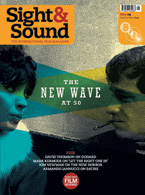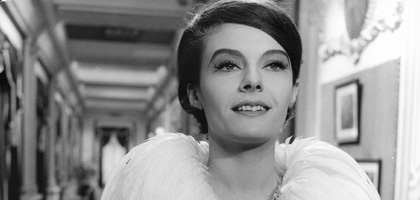
The New Wave at 50: Riding the wave

Sight & Sound asked six renowned directors from round the world to describe what the New Wave meant to them
Jacques Audiard
Films include: A Self-Made Hero (1995), Read My Lips (2001), The Beat That My Heart Skipped (2005)
They watched the world that moved around them and they realised that the old tools at their disposal to represent it did not work any longer, so they invented new ones. All of a sudden young women became really beautiful and really young. Therefore one should think about what tools one is using.

Catherine Breillat
Films include: 36 fillette (1988), Romance (1999), A ma soeur! (2001)
It was through the New Wave that I became aware that one could be young, unknown, not a professional film-maker and still make films. The directors of the nouvelle vague all more or less wrote for Cahiers [du cinéma], but as a provincial girl I didn't know the journal. I dreamed of their films through the titles (always nicely new and subversive) and the faces (unknown and new) - the faces of a new generation.
They taught me that cinema is a desire, not a school. Cinema just happens, full stop. Nobody can tell you how to do it or what the rules are. And you do it with new faces. Personally I don't like actors who have already been the bearers of other withered desires. Isn't the camera more suitable for discovering than for filming - for discovering the inner soul through those big, big, mystery-revealing close-ups of which I am so fond?
My favourite films of the nouvelle vague are Godard's, from Breathless (A bout de souffle) to Bande à part and Pierrot le fou. But I have special affinity with Une Femme est une femme (right). I particularly like the rigour of its framing, the impulsive yet carefully thought-out choices of colours, as well as its 'ultra-modernism' which is also 'ultra-mannered'. Such is the fate of modernism's wish to make a clean slate - sometimes it comes out as ultra chichi. And I love that!
Godard was obviously not a fool and his constant self-mockery doesn't take anything away from the cleverness of his construction. It's a wonderful film. I love the egocentric play-acting between Anna Karina and Jean-Paul Belmondo and the freedom and delight of the director in shifting between the playfulness of the performances and the scrupulous beauty of the framing and the sharp colours of that period. Obviously I was just fascinated, carried away - and influenced. I have always said that my film Tapage nocturne (Nocturnal Uproar, 1979) was a hidden remake of Une Femme est une femme.

Charles Burnett
Films include: Killer of Sheep (1977), To Sleep with Anger (1990)
The Glass Shield (1994)
I was in film school when the French New Wave was a part of the scene. The m0vement was an object of study. I have to mention Godard because he was always a part of a conversation. What I got was a sense of experimentation, a joy in making films. The New Wave created an atmosphere that you felt a part of. It made you want to go out and make movies.
The film that caused me to think about it most is Last Year at Marienbad. Resnais went out of his way to be obscure. Style was everything. In film school, if you understood it, it was a sign that you had the stuff to be a film-maker. To this day, I don't understand a frame of it. Godard was more accessible and meaningful because of his mischievous attitude. He seemed like a rebel within the New Wave.
Claude Chabrol
Films include: Le beau Serge (1959), Le Boucher (1970), La Cérémonie (1995)
I never really believed in the nouvelle vague. I remember writing a magazine article in the 1950s saying, "There are no waves, only the sea." With time I suppose you can see the existence of a movement which has gained in importance. These films were made with great naivety. I remember the Renoir film Toni from 1935, and that could have been in the New Wave. I suppose that the New Wave films were made less in the studios than out on the streets, and the characters were less stereotyped, the dialogue more to the point. What brought us together was what we didn't like rather than what we liked positively. Truffaut and Godard ended up by falling out. We're not like old war veterans meeting up together and talking about the past. We like to see each other, and have a good meal. (As told to Thomas Dawson)

Christophe Honoré
Films include: Ma mère (2004), Dans Paris (2006), Les Chansons d'amour (2007)
"Take the trouble to make your desires match your means" and "do not be scared of variety", from the 'Declaration of Rights and Duties of Cinema' as written by the nouvelle vague: these two commandments are like a motto for me.
Jacques Demy's Lola is one of the greatest films in the world, and therefore certainly one of the greatest films of the nouvelle vague. Followed closely by Pierrot le fou. Demy and Godard are the same thing, the same impulse, the same melancholy - a pop and popular culture married to a high conception of art. French cinema has never been so ambitious and widespread and desperate as it was in the 1960s. It's our golden age, our empire, our lost paradise. In the 19th century there was Hugo, Stendhal, Balzac, Flaubert. In the 20th, Truffaut, Demy, Godard, Rohmer. A touch of national pride every century is not so bad.
Hou Hsiao-Hsien
Films include: The Time to Live and the Time to Die (1985), A City of Sadness (1989), Three Times (2005)
The film I like most is Godard's Breathless. I saw it in Taipei just before shooting The Boys from Fengkuei (1983). I had a strong reaction to his use of the jump cut, so full of energy and life, very young, very new - you can't find it anywhere else in the cinema of that period. I heard later that Godard didn't have enough film in each roll; he had to cut when actors were performing in the middle of a scene. He asked them not to move, to stay where they were while he changed to another roll, and then they started again from where they stopped. During the montage, that caused the images to jump, but he didn't care. What he did is so brilliant. It deeply influenced my own ideas on montage in all my films since.
